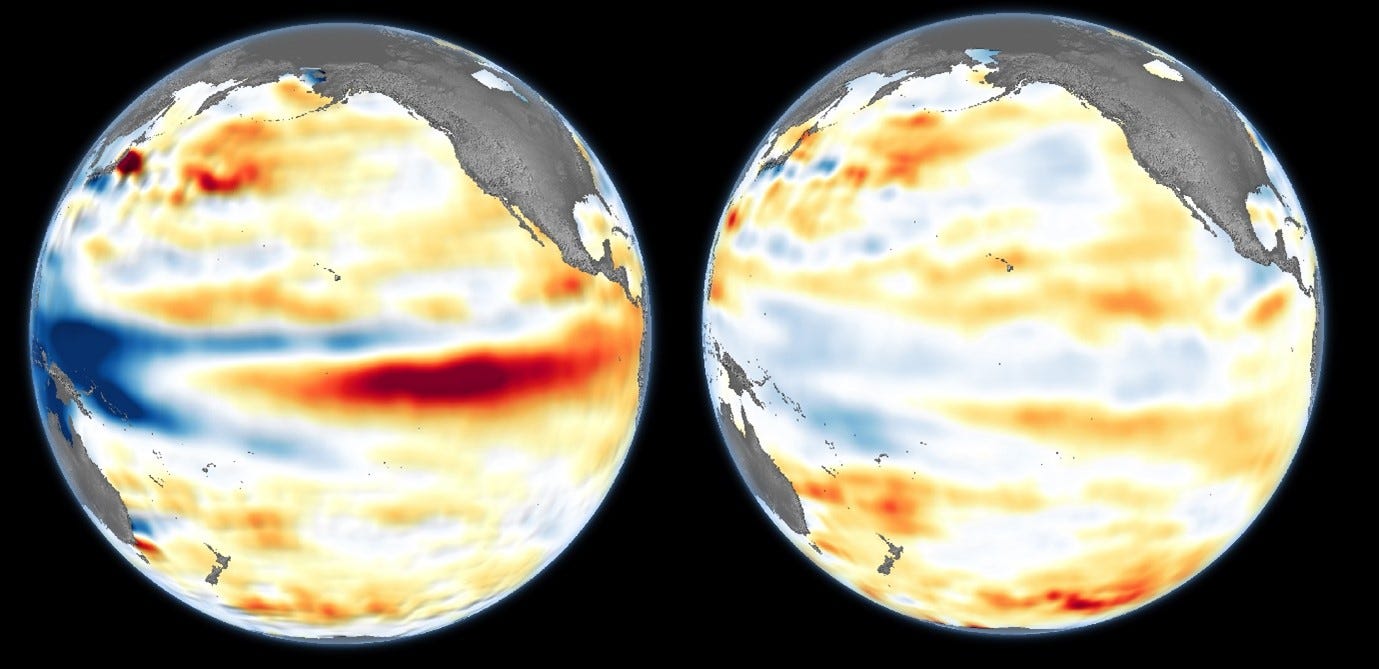Two short posts: Gaza deaths and El Nino
Consequences of conflict, and, Is a La Niña now likely?
[Two short posts, unrelated, other than they are contemporary.]
Gaza death toll
[Adapted from a recent article in The Lancet.]
By the end of June 2024 over 37,000 people had been killed in the Gaza Strip since the attack by Hamas in October 2023 and the subsequent Israeli invasion, according to the Gaza Health Ministry, and reported by the UN Office for the Coordination of Humanitarian Affairs. The Ministry's figures have been contested by the Israeli authorities, although they have been accepted as accurate by Israeli intelligence services, the UN, and World Health Organisation (WHO).
Collecting data is increasingly difficult for the Gaza Health Ministry due to the destruction of much of the infrastructure. The Ministry has had to augment its reporting (usually based on people dying in its hospitals or brought in dead) with information from other reliable media sources and first responders. Consequently, the Gaza Health Ministry now reports separately the number of unidentified bodies among the total death toll. As of May 10, 2024, 30% of the then 35,091 deaths were unidentified.
The number of reported deaths is likely to be an underestimate. The UN estimates that, by Feb 29, 2024, 35% of buildings in the Gaza Strip had been destroyed, so the number of bodies still buried in the rubble is likely to be substantial, with estimates of more than 10,000.
Armed conflicts have indirect health implications beyond the direct harm from violence. There are and will continue to be many indirect deaths in the coming months and years from causes such as reproductive, communicable, and non-communicable diseases. The future total death toll will be large given the intensity of the conflict, destroyed health-care infrastructure, severe shortages of food, water, and shelter, the population's inability to flee to safe places, and the loss of funding to UNRWA, one of the very few humanitarian organisations still active in the Gaza Strip. [Note the UK government has recently announced that its funding for the organisation will restart.]
The Gaza Health Ministry is the only organisation counting the dead. These data will be crucial for post-war recovery, restoring infrastructure, planning future humanitarian aid and ensuring historical accountability. In January 2024 the International Court of Justice required Israel to ‘take effective measures to prevent the destruction and ensure the preservation of evidence related to allegations of acts within the scope of … the Genocide Convention’.
El Niño ended – May 2024
Is a La Niña now likely?
[I have posted a previous post on the topic of El Niño / La Niña. You can find it here. ]
After heating up the eastern Pacific Ocean for about a year, El Niño ended in May 2024. The natural climate phenomenon contributed to many months of record-high ocean temperatures, precipitation extremes in Africa, low ice cover on the Great Lakes region of North America, and severe drought in the Amazon region of South America and Central America. As of July 2024, the eastern Pacific was in a neutral phase, but this situation is expected to last only until August 2024.
In tropical latitudes of the eastern Pacific, the ocean’s surface cools and warms cyclically in response to the strength of the trade winds - a phenomenon known as the El Niño Southern Oscillation (ENSO). This changing ocean disrupts atmospheric circulation in ways that intensify rainfall in some regions and bring drought to others.
In May 2023, easterly trade winds weakened and warm water from the western Pacific moved toward the western coast of the Americas, a sign that an El Niño had begun after 3 years of La Nina conditions. The El Niño continued to strengthen into December 2023 and then faded by mid-May 2024.
The maps below depict sea surface height anomalies across the central and eastern Pacific Ocean as observed on July 1st, 2024 (right), during the neutral phase, compared to December 4th, 2023 (left). Shades of red indicate areas where the ocean stood higher than normal; blues indicate sea levels that were lower than average; and normal sea level conditions appear white.
Source: NASA
Even at its peak in November and December 2023, the intensity of this El Niño did not match that of the largest events in recent decades. During the previous record setting events of 1997–1998 and 2015–2016, sea levels were much higher (warmer), and the high sea levels were spread over a much larger area of the central and eastern Pacific.
However, this moderately intense El Niño contributed to climate disturbances around the world:
· Precipitation patterns were disrupted in Africa: southern parts of Zambia suffered a dry spell that parched 50% of the maize grown, while the Horn of Africa region saw serious flooding.
· Drought in the Amazon led to large understory fires in the northern state of Roraima.
· El Niño also contributed to heat damage of coral reefs, heavy rainfall on the U.S. West Coast, low ice levels on the Great Lakes of North America, and fires in Indonesia.
In May 2024, easterly trade winds picked back up, bringing sea surface temperatures (and sea surface heights) back to normal in the eastern Pacific. NOAA’s Climate Prediction Centre forecast that a La Niña phenomenon is 70% likely to emerge between August and October 2024 and persist well into the following year.




